The Book of Numbers is the fourth book of the Hebrew Bible and the fourth of five books of the Jewish Torah. The book has a long and complex history; its final form is possibly due to a Priestly redaction of a Yahwistic source made sometime in the early Persian period. The name of the book comes from the two censuses taken of the Israelites.
The Book of Exodus is the second book of the Bible. It is a narrative of the Exodus, the origin myth of the Israelites leaving slavery in Biblical Egypt through the strength of their deity named Yahweh, who according to the story chose them as his people. The Israelites then journey with the legendary prophet Moses to Mount Sinai, where Yahweh gives the 10 commandments and they enter into a covenant with Yahweh, who promises to make them a "holy nation, and a kingdom of priests" on condition of their faithfulness. He gives them their laws and instructions to build the Tabernacle, the means by which he will come from heaven and dwell with them and lead them in a holy war to conquer Canaan, which has earlier, according to the myth of Genesis, been promised to the "seed" of Abraham, the legendary patriarch of the Israelites.
The Wilderness of Sin or Desert of Sin is a geographic area mentioned in the Hebrew Bible as lying between Elim and Mount Sinai. Sin does not refer to the moral concept of "sin", but comes from the Hebrew word Sîn, the Hebrew name for this region.
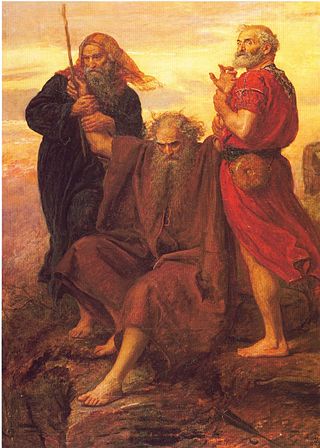
Rephidim or Refidim is one of the places visited by the Israelites in the biblical account of the Exodus from Egypt.
Pi-HaHiroth, is the fourth station of the Exodus mentioned in Exodus 14:2. The fifth and sixth stations Marah and Elim are located on the Red Sea. The biblical books Exodus and Numbers refer to Pi-HaHiroth as the place where the Israelites encamped between Migdol and the sea, opposite Baal Zephon, while awaiting an attack by Pharaoh, prior to crossing the Red Sea. Reaching Pi-HaHiroth involved turning back from the direction they had been traveling and going south directly opposite of God's preferred proximate destination of Kadesh Barnea at the entrance to the Philistine territory, which was done in order to gain time to boost the morale of the Israelites; their ultimate destination was the Abrahamic city of Hebron, east of the Philistine capital Gaza.

The Crossing of the Red Sea or Parting of the Red Sea is an episode in the origin myth of The Exodus in the Hebrew Bible.
The historicity of the Bible is the question of the Bible's relationship to history—covering not just the Bible's acceptability as history but also the ability to understand the literary forms of biblical narrative. One can extend biblical historicity to the evaluation of whether or not the Christian New Testament is an accurate record of the historical Jesus and of the Apostolic Age. This tends to vary depending upon the opinion of the scholar.
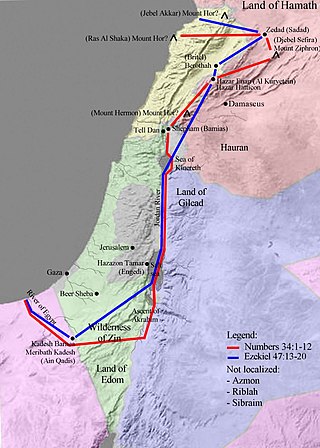
Kadesh or Qadesh or Cades is a place-name that occurs several times in the Hebrew Bible, describing a site or sites located south of, or at the southern border of, Canaan and the Kingdom of Judah in the kingdom of Israel. Many modern academics hold that it was a single site, located at the modern Tel el-Qudeirat, while some academics and rabbinical authorities hold that there were two locations named Kadesh. A related term, either synonymous with Kadesh or referring to one of the two sites, is KadeshBarnea. Various etymologies for Barnea have been proposed, including 'desert of wanderings,' but none have produced widespread agreement.

The Exodus is the founding myth of the Israelites whose narrative is spread over four of the five books of the Pentateuch.
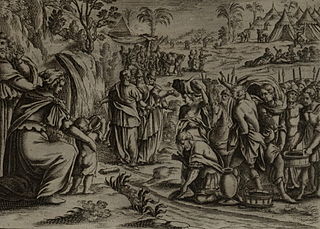
Marah is one of the locations which the Exodus identifies as having been travelled through by the Israelites, during the Exodus.

Elim, according to the Hebrew Bible, was one of the places where the Israelites camped following their Exodus from Egypt. It is referred to in Exodus 15:27 and Numbers 33:9 as a place where "there were twelve wells of water and seventy date palms," and that the Israelites "camped there near the waters".
Kibroth Hattaavah or Kibroth-hattaavah is one of the locations which the Israelites passed through during their Exodus journey, recorded in the Book of Numbers. It was at this place, according to the biblical narrative, that the Israelites loudly complained about constantly eating only manna, and that they had enjoyed a much more varied diet, of fish, vegetables, fruit and meat, when they lived in Egypt; the text states that this led Moses, in despair, to cry out to Yahweh, who then promised them so much meat that 'they would vomit it through their nostrils'. The narrative goes on to tell of a huge number of quails brought by the winds to both sides of the Israelite encampment, which the people gathered. Modern translations imply that Yahweh sent the plague as they were chewing the first meat that fell
Massah and Meribah are place names found in the Hebrew Bible. The Israelites are said to have travelled through Massah and Meribah during the Exodus, although the continuous list of visited stations in Numbers 33 does not mention this. In Exodus 17:7, Meribah is mentioned at the same time as Massah, in a context which suggests that Massah is the same location as Meribah, but other biblical mentions of Massah and Meribah, such as that in the Blessing of Moses seem to imply that they are distinct. Massah and Meribah are also referred to in several other places in the Bible.

Mount Sinai is the mountain at which the Ten Commandments were given to Moses by God, according to the Book of Exodus in the Hebrew Bible. In the Book of Deuteronomy, these events are described as having transpired at Mount Horeb. "Sinai" and "Horeb" are generally considered by scholars to refer to the same place.
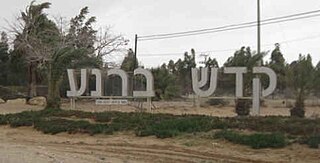
Nitzanei Sinai, also known as Kadesh Barnea, is a community settlement in the western Negev desert in Israel. Located near Nitzana, it falls under the juridisction of Ramat HaNegev Regional Council. In 2022 it had a population of 303.
According to the Book of Numbers, Taberah is one of the locations which the Israelites passed through during their Exodus journey. The biblical narrative states that the place received its name, which means the pӀace of burning, because the fire of the LORD had burned there in anger because of their continued complaints. The text states that the fire first burned at the outskirts of the Israelite camp, killing some of those who lived on the edge of the group, but it was extinguished when Moses prayed on the people's behalf.
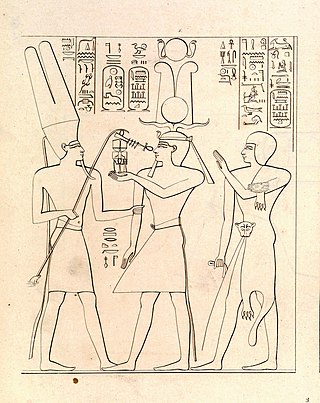
The Bible makes reference to various pharaohs of Egypt. These include unnamed pharaohs in events described in the Torah, as well as several later named pharaohs, some of whom were historical or can be identified with historical pharaohs.
Wadi Gharandel is a wadi in western Sinai, Egypt.
The Exodus is the founding myth of the Israelites. The scholarly consensus is that the Exodus, as described in the Torah, is not historical, even though there may be a historical core behind the Biblical narrative.
Tell el-Qudeirat is an archaeological site in the Sinai, about 5 mi (8.0 km) east of the Egyptian village of Quseima. It is widely considered to be the location of the biblical Kadesh Barnea. Recently, some authors have referred to it as Tel Kadesh-barnea. Moshe Dothan (1965) referred to it as Tel 'Ein el Qudeirat, while in the early twentieth century Woolley and Lawrence used the spelling Tell Ain el Guderat.












